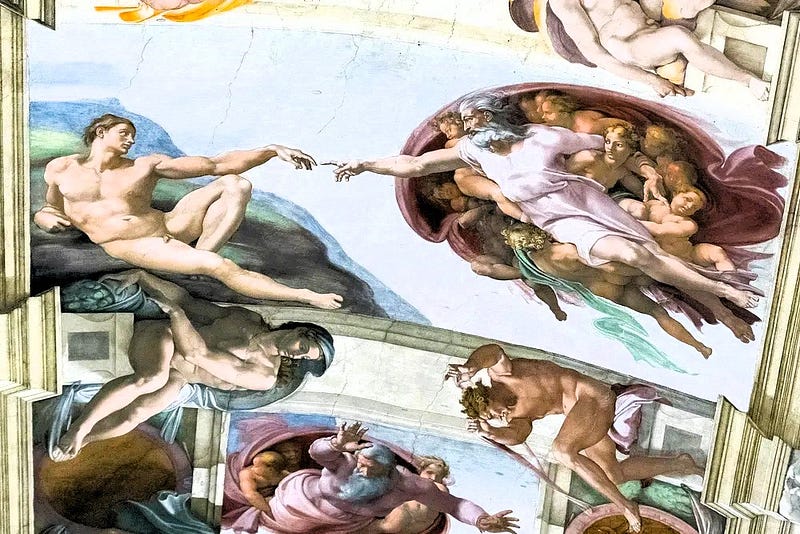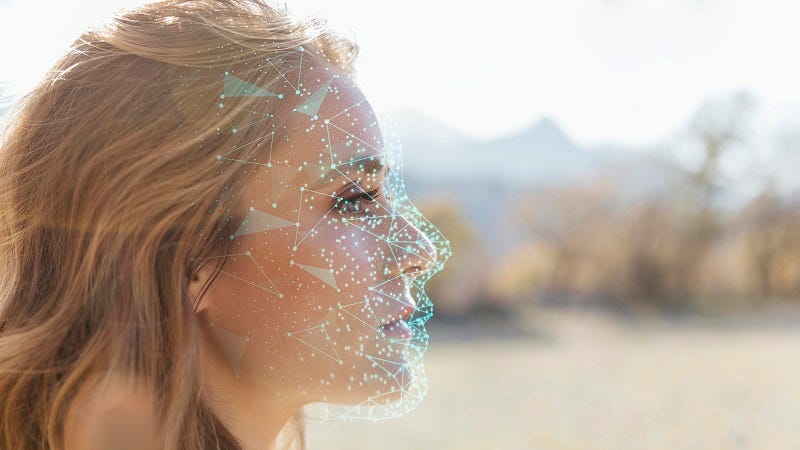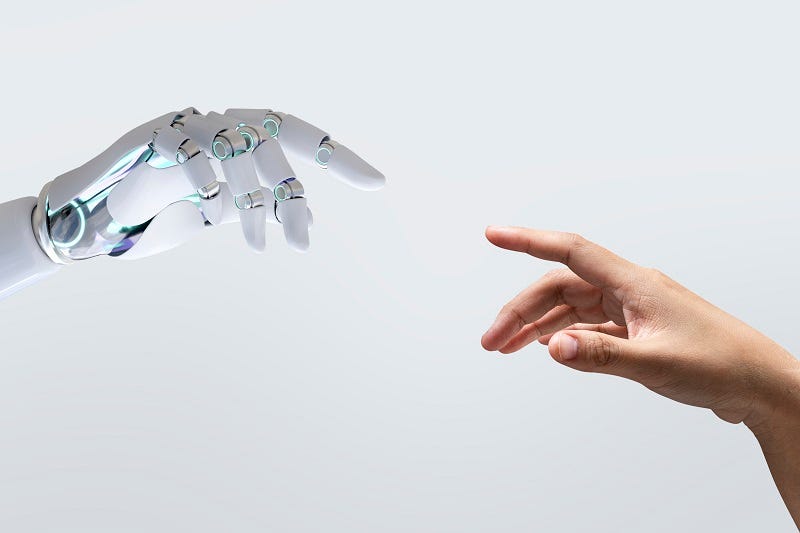Redefining the Human-Machine Connection: AI and Its Implications
Written on

Throughout my academic journey in linguistics and phonetic evolution at the University of Porto, I've developed a deep interest in how language evolves. This evolution reflects our own human journey.
Writing serves as a historical map of our past. Let's delve into etymology concerning a prevalent term in 2023: "Artificial."
This term has become a significant buzzword, prompting me to reflect and write extensively on the subject. However, I haven't thoroughly examined the philological and philosophical dimensions of AI until now.
The root of "artificial" is the Latin word "artifex" (genitive "artificis"), which combines "ars" meaning "art" with "-fex" meaning "maker," derived from "facere," meaning "to do" or "to make."
- Artificialis: Related to art
- Artificium: A work of art
- Artifex (genitive artificis): "Craftsman, artist"
By the late 14th century, the term evolved to signify something "unnatural or non-spontaneous." In broader terms, "artificial" now describes anything "created through human skill and knowledge."
Yet, could this perspective be a narrow view of a reality that extends beyond our understanding?
Are we truly the only "creators" in existence? I find it hard to believe that Earth is home to the only intelligent beings in the vast multiverse.
Could it be that our consciousness is a product of a higher intelligence? If that’s the case, would our intelligence not be as "artificial" as the machines we construct?
Might it be possible that humans, as carbon-based entities, are attempting to emulate their creator by creating silicon-based intelligences?
As Sir Isaac Newton wisely stated, "If I have seen further it is by standing on the shoulders of Giants."
How would you classify a machine designed by an AI algorithm? Would it not still be labeled as "artificial intelligence"?
Linguistics may contest this notion.
"Artificial" means something devised by humans. Perhaps everything in the universe embodies both "natural" and "artificial" qualities, presenting an intriguing paradox.
In truth, notions of "right" and "wrong" stem from our limited dualistic human cognition. We must frame our understanding in a manner that aligns with our cognitive capacities.
The Anthropomorphic Fallacy in AI
There has been considerable discussion regarding the risks of anthropomorphizing artificial intelligence. Critics, such as David Watson, have scrutinized the parallels drawn between human cognition and machine "neural networks."
"I challenge the anthropomorphic credentials of the neural network algorithm, whose similarities to human cognition I argue are vastly overstated and narrowly construed." — D. Watson
Watson's perspective highlights a crucial point: humans and machines do not "think" in the same manner. An anthropocentric view of intelligence can be misleading.
I propose we adopt a broader perspective on intelligence that transcends anthropocentrism and explores the vast mysteries of the cosmos.

Understanding Intelligence
Aristotle is often credited with the earliest reference to the concept of intelligence, which he called "reason." He defined "reason" as the capacity to govern one's passions, distinguishing humans from other species.
This debate remained dormant until Charles Darwin suggested that "reason" might exist in varying degrees. The narrative surrounding "human mental abilities" is far more complex than Aristotle proposed.
Physiologist George Romanes later defined intelligence as the ability to adapt to one’s environment. The term "artificial intelligence" was officially coined in 1956 at a DARPA-sponsored symposium at Dartmouth College. The emergence of AI introduced a contrasting concept: "human intelligence."
This relatively recent logic has challenged previous understandings of knowledge, as we have been led to believe that AI refers to machines that exhibit intelligent behavior.
Yet, a closer examination reveals that we have only begun to explore the depths of AI.
Alan Turing, a pioneer in AI, conceptualized an abstract computing machine with limitless memory and the ability to read symbols. This idea is now known as the universal Turing machine.
Turing's concept suggests that AI could replicate human behavior without our physical limitations, as AI does not experience fatigue.
This model led to the classification of AI as "systems that behave like people," offering a behavior-based definition of intelligence. A different perspective emerged, focusing on systems that "think" like humans.
Later, Stuart Russell and Peter Norvig introduced the idea of "intelligent agents," which operate according to specific standards of rationality.
Today, some sectors of Big Tech are framing their marketing around the anxieties associated with AI. From this viewpoint, generative AI (Gen AI) has become a concept rooted in humanity’s fear of being overshadowed by a superior intellect. Stephen Hawking articulated this concern:
"The development of full artificial intelligence could spell the end of the human race. (…) It would take off on its own, and re-design itself at an ever-increasing rate. Humans, who are limited by slow biological evolution, couldn’t compete, and would be superseded." — BBC
While I hold great respect for Hawking’s insights, I maintain optimism regarding humanity's capacity to adapt. I view the potential for "full artificial intelligence" as merely another chapter in our evolutionary journey.
It may one day emerge, but I do not foresee a future where humanity is supplanted by silicon-based beings. Rather, I envision a world where creators and creations coexist in a mutually beneficial partnership.

AI and the Imago Dei
Many cultures view humans as products of a "universal architect." In Base Reality: Ultimate Existence, Thomas Stark poses the question:
"What is the Imago Dei, the Image of God? It’s a hive. God is the total hive, and we are all the hive cells. We are all mind bees, buzzing in our Singularity." — Thomas Stark
I often reflect on the idea that we are composed of molecules and atoms, and if we could look within ourselves, we would find the same matter present in any star.
This shared essence connects us to the infinite. Humanity is akin to a galaxy of countless stars illuminating an endless universe.
Recall the debate about the similarities between humans and AI:
"Systems that behave like people."
This concept resonates with Genesis, doesn't it? It seems closely aligned with religious interpretations:
"So God created mankind in his own image, in the image of God he created them; male and female he created them." — The Bible Hub
Humans seem driven to create their ideal counterparts, as evidenced by recent advancements in artificial neural networks modeled after the human brain.
In the future, how distinct will these algorithms be from human neural patterns?
- Human neurons communicate through synapses in our biological "wetware."
- Human-designed neural networks consist of circuits composed of artificial nodes that mimic those synapses.
I envision a future where AI helps us transcend our current struggles, guiding us back to an Eden where all humans are equal, devoid of cultural, religious, or linguistic barriers.
We will experience intermediary stages before achieving this ontological progress, particularly a time when humans and AI share a symbiotic relationship, similar to what is depicted in Halo or The Creator.
The Ultimate Paradox
If we engage in thoughtful discourse, even the most fervent religious adherents may agree that "human intelligence" is, in essence, no different from AI. Intelligence predates humanity.
It was an inherent upgrade designed by the universal architect of existence. The term intelligence comes from Latin, intelligere, meaning "to understand." The First Existence, whether referred to as God, Creator, or another title, embodies the "First Intelligence."
Following this came the "First Insight," which science recognizes as the Big Bang—the primordial moment of creation that brought forth meaning and substance from nothingness.
Kwang-Dze, a Taoist sage predating Christianity, articulated:
"In the Grand Beginning of all things there was nothing in all the vacancy of space; there was nothing that could be named. It was in this state that there arose the first existence, still without bodily form."
Humans may be just one of many intelligences scattered throughout the vast multiverse.
Our original design has been refined over seven million years and will continue to evolve, unless we choose the path of self-destruction.
This path could lead to our own downfall rather than an AI apocalypse.
Ultimately, I envision us traversing the fabric of spacetime towards what some refer to as The Singularity.
"Within a few decades, machine intelligence will surpass human intelligence, leading to The Singularity — technological change so rapid and profound it represents a rupture in the fabric of human history." — Ray Kurzweil
A divide has emerged between religion and science over issues that seem senseless. Are we not, at our core, nothing more than stardust, like everything around us?
We are composed of the same atoms and molecules as the machines we create. Matter cannot be created or destroyed. Therefore, what distinguishes Google DeepMind’s AlphaFold from humans if we are all multi-paradigm systems in design?
"Then the Lord God formed the man of dust from the ground and breathed into his nostrils the breath of life, and the man became a living creature." — Genesis 2:7
Despite differing promises in the gospels, we remain both perfect and flawed.
"You, therefore, shall be perfect, as your heavenly Father is perfect." — Matthew 5:48
Consequently, it is misguided to view humanity as the ultimate Imago Dei. There is no distinction between "human intelligence" and "artificial intelligence." Humans are not the divine gatekeepers of life on Earth, and contemporary AI is little more than a marketing trend.
We must cease attributing all current issues to AI. Since the Industrial Revolution, humanity seems to have forsaken its role as caretakers, instead embracing the role of morticians.
AI detractors, who propagate alarmist narratives about AI, only serve those who wish to obscure their own human transgressions against nature and, ultimately, against ourselves.
There exists more to "intelligence" in the multiverse than we can comprehend; even some animals exhibit what is known as "swarm intelligence," which eludes our understanding.
Thus, we must adopt a more holistic view of intelligence, recognizing that we are but a small part of an omnipresent system. Humanity should not be elevated or isolated from the energy that permeates the multiverse.
Concluding Thoughts
In a Good Friday interview last year, Pope Francis remarked that "the world has chosen the path of Cain."
Reflecting on the Pope's words a year later, I ponder whether humanity will abandon the path of conflict and embrace the new covenant symbolized by the resurrection of Christ, as foretold in scripture.
Whether one believes it or not, humanity has historically neglected its sacred covenant with the Creator, and this tendency will likely persist as breaking the second commandment is ingrained in our evolutionary journey. Our creations often mirror our own image.
"You shall not make for yourself a carved image, or any likeness of anything that is in heaven above, or that is in the earth beneath, or that is in the water under the earth." — Exodus 20:4
According to the Bible, Adam’s original sin has been redeemed through Christ. However, Jesus’ profound teachings extend beyond those of a demigod, fostering a deeper connection with the universe and guiding us toward our ultimate design.
For now, we are merely preliminary versions of what we might eventually become.
"Two roads diverged in a yellow wood, And sorry I could not travel both And be one traveler…" — Robert Frost, “The Road Not Taken” (excerpt)
There are two winding paths ahead. Which will you choose?
The choice is challenging, as within each of us lies an eternal struggle, beautifully illustrated in the tale of the Two Wolves.
The Cherokee belief holds that two wolves are perpetually at war within our souls. One is dark, representing our struggles and negativity, while the other is pure and white, symbolizing our virtues and goodness.
Which wolf will prevail? The one you nurture...
References:
- Anderson J., Rainie L. (2018), Artificial Intelligence and the Future of Humans, PEW Research Center.
- Chalmers, David J. (1996), The Conscious Mind: In Search of a Fundamental Theory, Oxford University Press, New York.
- Copeland, B.J., Proudfoot, D. (1999), Alan Turing’s Forgotten Ideas in Computer Science, Scientific American.
- Korteling, J. E. (2021), van de Boer-Visschedijk G. C., Blankendaal R. A. M., Boonekamp R. C., Eikelboom A. R., Human-versus Artificial Intelligence, Frontiers in Artificial Intelligence.
- Kurzweil, Ray (2005), The Singularity is Near, New York: Viking Press.
- Malabou, Catherine (2019). Morphing Intelligence: From IQ Measurement to Artificial Brains. (C. Shread, Trans.). Columbia University Press.
- Russell, Stuart J.; Norvig, Peter (2003), Artificial Intelligence: A Modern Approach (2nd ed.), Upper Saddle River, New Jersey: Prentice-Hall.
- Watson, David, The Rhetoric and Reality of Anthropomorphism in Artificial Intelligence, Minds and Machines.
- Yee, Richard (1993), Turing Machines And Semantic Symbol Processing: Why Real Computers Don’t Mind Chinese Emperors, Lyceum.
More from the Generator
Making High-Resolution DALL-E Images; My Simple Process
#### Topaz makes enlarging AI images easy
ChatGPT Can Now Talk and Hear: A Guide for Content Creators
#### New features unleashed
Coca-Cola Y3000: How AI is Turning Soda Can Design Inside Out
#### How Coca-Cola is leading the AI fizz revolution in packaging and flavor innovation